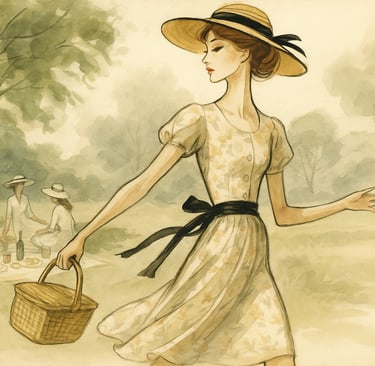The Picnic as a Feminist Rebellion: How Suffragettes Used Outdoor Eating to Claim Space
Discover how suffragettes turned the picnic into a quiet act of rebellion, using outdoor eating to claim public space, build solidarity, and defy gender roles.
FOOD HISTORY & TRADITIONS


When we think of a picnic today, we imagine leisure: gingham blankets spread across green grass, wicker baskets filled with sandwiches and fruit, the sound of laughter drifting on a summer breeze. But in the early 20th century, for the women fighting for the right to vote, a picnic was far more than a pleasant afternoon. For suffragettes across Britain and beyond, it became a quiet yet radical act of protest—a way to claim public space, defy gender expectations, and build solidarity outside the walls of the drawing room.
Women, Public Space, and the Power of the Blanket
At the turn of the century, society drew sharp lines between where men and women belonged. Men filled the streets, parks, and public houses, holding meetings, playing sports, and gathering in visible, communal ways. Women, meanwhile, were expected to remain in private or controlled spaces: homes, gardens, or carefully supervised social clubs.
The suffragette movement, while best remembered for its rallies, marches, and hunger strikes, also found power in subtler tactics. Among these was the picnic—a seemingly innocent gathering that doubled as a reclamation of public ground.Groups of women would organise to meet in parks, commons, and open countryside, laying out blankets and unpacking simple meals of bread, cheese, fruit, and tea.
What might have looked like a social outing was, in context, a statement: women belonged in public. They could gather, speak, sing, and take up space just as freely as men, and they could do it without needing permission or supervision. The picnic blanket, in its way, became a banner—an assertion of visibility, independence, and the right to exist and organise in the open air.
Informality as Rebellion
Picnics also challenged another social structure: the rigid, male-dominated etiquette of formal dining. At a time when meals were often orchestrated around strict seating plans, gendered expectations, and the oversight of men, eating outdoors allowed women to throw off those constraints.
Around a picnic spread, there was no head of the table, no fine china, and no rules about who could speak when. Women laughed, debated, and planned without the interruption or control of fathers, husbands, or brothers. For suffragette organisers, these gatherings were more than a morale boost—they were spaces where women could strategise, recruit, and strengthen the bonds that sustained the movement.
The informality also carried symbolic weight. By embracing a communal, unstructured meal, suffragettes rejected the notion that women’s place in society was solely tied to serving and smoothing domestic life. In the park or on the heath, they weren’t hostesses or silent companions; they were comrades, equals, and activists.
Building Solidarity in the Open
Not all suffragette activism was combative. While protests, speeches, and, in some cases, acts of civil disobedience captured headlines, quieter forms of unity were just as vital to the cause. The picnic, with its shared food and shared purpose, gave women a chance to recharge and reconnect outside the pressures of marches and public confrontation.
These gatherings often doubled as fundraisers or opportunities to distribute pamphlets and plan upcoming demonstrations. In some cases, women would invite sympathetic journalists to cover the events, knowing that photographs of confident, smiling women gathered in public would help shift the image of suffragettes from militant disruptors to relatable, determined citizens.
Some organisations even leaned into the symbolism, producing custom picnic sets decorated in the suffragette colours of green, white, and purple. These baskets, cups, and plates turned every outing into a statement: even over bread and tea, the cause for women’s rights was alive and visible.
Fun Fact: Suffragette Summer Camps
Beyond picnics, some suffragette groups organised multi-day outdoor retreats and camps during the summer months. These events combined relaxation, skill-sharing, and activism, with women sleeping in tents or cabins, swimming, hiking, and learning public speaking and self-defence. Mealtimes—often taken picnic-style—were central to the experience, reinforcing the idea that women could build their own spaces of freedom, camaraderie, and strength away from the structures of traditional domestic life.
Why the Picnic Still Feels Radical
The suffragette picnic might seem like a relic of another era, but its spirit lingers. Outdoor gatherings remain a powerful tool for activism, from feminist marches to Pride celebrations, where public space becomes a canvas for visibility and connection.
In reclaiming the picnic as more than leisure, suffragettes showed how even simple acts—sharing a meal, sitting on a blanket, inhabiting a park—could carry revolutionary weight when done by those denied equality. They taught us that activism doesn’t always roar; sometimes it hums, softly, over sandwiches and tea, beneath the open sky.
So the next time you pack a basket and head to the park, remember that for some women a century ago, that act alone was defiance. It was a reminder that they, too, deserved the sun, the space, and the freedom to gather—not as accessories to a man’s world, but as full participants shaping a new one.
